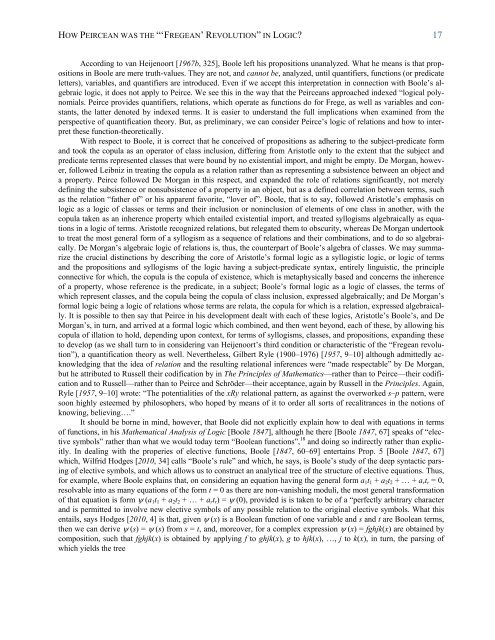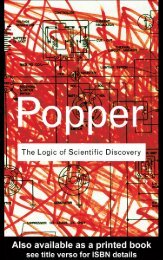Create successful ePaper yourself
Turn your PDF publications into a flip-book with our unique Google optimized e-Paper software.
HOW PEIRCEAN WAS THE “‘FREGEAN’ REVOLUTION” IN LOGIC? 17<br />
According to van Heijenoort [1967b, 325], Boole left his propositions unanalyzed. What he means is that propositions<br />
in Boole are mere truth-values. They are not, and cannot be, analyzed, until quantifiers, functions (or predicate<br />
letters), variables, and quantifiers are introduced. Even if we accept this interpretation in connection with Boole’s algebraic<br />
logic, it does not apply to Peirce. We see this in the way that the Peirceans approached indexed “logical polynomials.<br />
Peirce provides quantifiers, relations, which operate as functions do for Frege, as well as variables and constants,<br />
the latter denoted by indexed terms. It is easier to understand the full implications when examined from the<br />
perspective of quantification theory. But, as preliminary, we can consider Peirce’s logic of relations and how to interpret<br />
these function-theoretically.<br />
With respect to Boole, it is correct that he conceived of propositions as adhering to the subject-predicate form<br />
and took the copula as an operator of class inclusion, differing from Aristotle only to the extent that the subject and<br />
predicate terms represented classes that were bound by no existential import, and might be empty. De Morgan, however,<br />
followed Leibniz in treating the copula as a relation rather than as representing a subsistence between an object and<br />
a property. Peirce followed De Morgan in this respect, and expanded the role of relations significantly, not merely<br />
defining the subsistence or nonsubsistence of a property in an object, but as a defined correlation between terms, such<br />
as the relation “father of” or his apparent favorite, “lover of”. Boole, that is to say, followed Aristotle’s emphasis on<br />
logic as a logic of classes or terms and their inclusion or noninclusion of elements of one class in another, with the<br />
copula taken as an inherence property which entailed existential import, and treated syllogisms algebraically as equations<br />
in a logic of terms. Aristotle recognized relations, but relegated them to obscurity, whereas De Morgan undertook<br />
to treat the most general form of a syllogism as a sequence of relations and their combinations, and to do so algebraically.<br />
De Morgan’s algebraic logic of relations is, thus, the counterpart of Boole’s algebra of classes. We may summarize<br />
the crucial distinctions by describing the core of Aristotle’s formal logic as a syllogistic logic, or logic of terms<br />
and the propositions and syllogisms of the logic having a subject-predicate syntax, entirely linguistic, the principle<br />
connective for which, the copula is the copula of existence, which is metaphysically based and concerns the inherence<br />
of a property, whose reference is the predicate, in a subject; Boole’s formal logic as a logic of classes, the terms of<br />
which represent classes, and the copula being the copula of class inclusion, expressed algebraically; and De Morgan’s<br />
formal logic being a logic of relations whose terms are relata, the copula for which is a relation, expressed algebraically.<br />
It is possible to then say that Peirce in his development dealt with each of these logics, Aristotle’s Boole’s, and De<br />
Morgan’s, in turn, and arrived at a formal logic which combined, and then went beyond, each of these, by allowing his<br />
copula of illation to hold, depending upon context, for terms of syllogisms, classes, and propositions, expanding these<br />
to develop (as we shall turn to in considering van Heijenoort’s third condition or characteristic of the “Fregean <strong>revolu</strong>tion”),<br />
a quantification theory as well. Nevertheless, Gilbert Ryle (1900–1976) [1957, 9–10] although admittedly acknowledging<br />
that the idea of relation and the resulting relational inferences were “made respectable” by De Morgan,<br />
but he attributed to Russell their codification by in The Principles of Mathematics—rather than to Peirce—their codification<br />
and to Russell—rather than to Peirce and Schröder—their acceptance, again by Russell in the Principles. Again,<br />
Ryle [1957, 9–10] wrote: “The potentialities of the xRy relational pattern, as against the overworked s–p pattern, were<br />
soon highly esteemed by philosophers, who hoped by means of it to order all sorts of recalitrances in the notions of<br />
knowing, believing….”<br />
It should be borne in mind, however, that Boole did not explicitly explain how to deal with equations in terms<br />
of functions, in his Mathematical Analysis of Logic [Boole 1847], although he there [Boole 1847, 67] speaks of “elective<br />
symbols” rather than what we would today term “Boolean functions”, 18 and doing so indirectly rather than explicitly.<br />
In dealing with the properies of elective functions, Boole [1847, 60–69] entertains Prop. 5 [Boole 1847, 67]<br />
which, Wilfrid Hodges [2010, 34] calls “Boole’s rule” and which, he says, is Boole’s study of the deep syntactic parsing<br />
of elective symbols, and which allows us to construct an analytical tree of the structure of elective equations. Thus,<br />
for example, where Boole explains that, on considering an equation having the general form a1t1 + a2t2 + … + artr = 0,<br />
resolvable into as many equations of the form t = 0 as there are non-vanishing moduli, the most general transformation<br />
of that equation is form ��(a1t1 + a2t2 + … + artr) = ��(0), provided is is taken to be of a “perfectly arbitrary character<br />
and is permitted to involve new elective symbols of any possible relation to the original elective symbols. What this<br />
entails, says Hodges [2010, 4] is that, given ��(x) is a Boolean function of one variable and s and t are Boolean terms,<br />
then we can derive ��(s) = ��(s) from s = t, and, moreover, for a complex expression ��(x) = fghjk(x) are obtained by<br />
composition, such that fghjk(x) is obtained by applying f to ghjk(x), g to hjk(x), …, j to k(x), in turn, the parsing of<br />
which yields the tree





